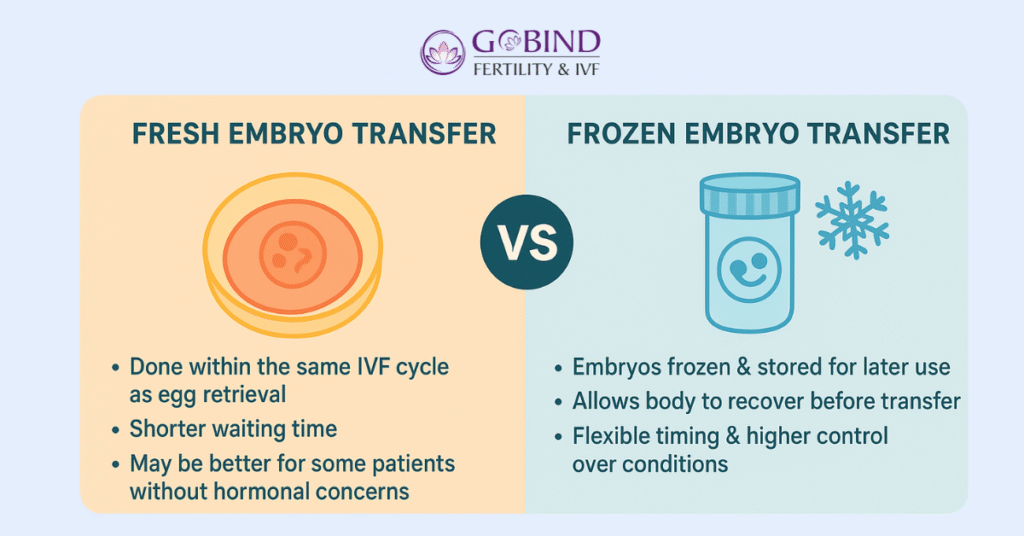Frozen vs. Fresh Embryo Transfer: Pros, Cons & Ideal Candidates

In vitro fertilisation (IVF) has brought hope to millions of couples struggling with infertility. One of the most important decisions during IVF treatment is choosing between frozen embryo transfer (FET) and fresh embryo transfer. Both methods are widely used and successful, but which one is right for you?
At Gobind Fertility & IVF Centre, the leading IVF centre in Hisar, we help patients understand the pros and cons of each technique so they can make informed decisions. Let’s dive into the key differences between frozen and fresh embryo transfers, including their benefits, drawbacks, and who can benefit most from each.
What is Fresh Embryo Transfer?
A fresh embryo transfer involves transferring an embryo into the woman’s uterus just a few days (usually 3 to 5 days) after egg retrieval and fertilisation during the same IVF cycle. There is no freezing or storage involved.
Pros of Fresh Embryo Transfer:
- Faster process: As embryos are transferred immediately, the IVF process is completed sooner.
- Natural progression: The embryo is implanted in the same cycle as retrieval, mimicking natural conception.
- Avoids freezing process: No risk of embryo damage from the freezing and thawing process.
Cons of Fresh Embryo Transfer:
- Hormonal imbalance: Ovarian stimulation drugs can disrupt the natural hormonal environment, affecting implantation.
- Lower implantation rates in some patients, especially those with high estrogen levels or PCOS.
- Less flexibility: Timing is crucial, and uterine conditions may not always be ideal immediately after stimulation.
What is Frozen Embryo Transfer (FET)?
In a frozen embryo transfer, embryos are cryopreserved (frozen) after fertilisation and stored for future use. The transfer is done in a later cycle, once the uterus is optimally prepared.
Pros of Frozen Embryo Transfer:
- Better endometrial preparation: The uterus can be hormonally optimised in a later cycle, increasing the chance of successful implantation.
- Higher success rates are seen in certain patients, especially women with PCOS, hormonal imbalances, or a thin endometrial lining.
- Safer for high responders: Reduces the risk of ovarian hyperstimulation syndrome (OHSS).
- More control and planning: Allows couples to take a break and recover before transfer.
- Additional chances: Multiple embryos can be frozen, giving more attempts in the future without repeating the full IVF cycle.
Cons of Frozen Embryo Transfer:
- Takes longer: The process involves an additional waiting period for endometrial preparation.
- Freezing/thawing risk: Though rare, there is a small risk of embryo damage during the freezing or thawing process.
- Extra costs: Cryopreservation and storage involve additional expenses.
Success Rates: Fresh vs. Frozen
Recent studies have shown that frozen embryo transfers can offer equal or even higher success rates compared to fresh transfers. At Gobind Fertility & IVF Centre, our data indicates that FETs especially benefit women with PCOS, endometriosis, or poor response to hormonal stimulation.
Our advanced IVF lab in Hisar uses the latest vitrification techniques for freezing embryos, ensuring minimal damage and excellent survival rates upon thawing.
Who Should Opt for Fresh Embryo Transfer?
Fresh embryo transfer may be suitable for:
- Women under 35 with good ovarian response and no hormonal imbalances.
- First-time IVF patients with normal uterine lining.
- Couples looking for quicker treatment cycles.
- Those with only a few embryos and no plan for multiple IVF cycles.
Who Should Opt for Frozen Embryo Transfer?
Frozen embryo transfer is ideal for:
- Women with PCOS or high oestrogen levels during stimulation.
- Patients are at risk for OHSS (ovarian hyperstimulation syndrome).
- Women with a thin or poor endometrial lining during the fresh cycle.
- Couples using donor eggs or surrogates.
- Patients who need PGT (preimplantation genetic testing).
- Those who want to delay pregnancy due to personal or medical reasons.
Personalized IVF Care at Gobind Fertility & IVF Centre, Hisar
At Gobind Fertility & IVF Centre, we understand that every couple’s fertility journey is unique. Our team of expert fertility specialists, led by the best IVF doctors in Hisar, provide customized treatment plans based on individual patient needs.
Whether you opt for a fresh or frozen embryo transfer, our goal is to ensure the highest success rates with safe and ethical practices. We offer:
- State-of-the-art IVF lab with embryo freezing and storage.
- Personalised fertility counselling and endometrial monitoring.
- Advanced hormonal support protocols for FET.
- Transparent guidance on cost, timeline, and success chances.
Conclusion: Which One is Right for You?
There is no one-size-fits-all answer to the frozen vs. fresh embryo transfer debate. The ideal choice depends on your medical history, response to treatment, uterine condition, and personal preferences.
Discussing your options with the specialists at Gobind Fertility & IVF Centre in Hisar can help you choose the best approach for a successful pregnancy. Our compassionate team is here to guide you every step of the way.
Need help deciding between fresh and frozen embryo transfer?
Book your consultation with the fertility experts at Gobind Fertility & IVF Centre, Hisar, today. Call us or visit [insert website URL] to schedule your appointment.
